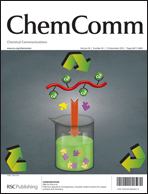DFT characterization of the reaction pathways for terminal- to μ-hydrideisomerisation in synthetic models of the [FeFe]-hydrogenase active site†‡
Abstract
The mechanism of terminal- to
![Graphical abstract: DFT characterization of the reaction pathways for terminal- to μ-hydride isomerisation in synthetic models of the [FeFe]-hydrogenase active site](/en/Image/Get?imageInfo.ImageType=GA&imageInfo.ImageIdentifier.ManuscriptID=C0CC02821E&imageInfo.ImageIdentifier.Year=2010)
- This article is part of the themed collection: Hydrogen

 Please wait while we load your content...
Please wait while we load your content...